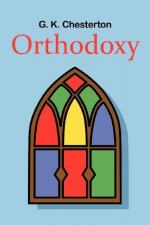
|
| Name: _________________________ | Period: ___________________ |
This test consists of 5 multiple choice questions, 5 short answer questions, and 10 short essay questions.
Multiple Choice Questions
1. Why does Christianity mark the graves of the martyr and the suicide?
(a) To show him who died for the sake of life and he who died for the sake of death.
(b) To show the horror of the suicide.
(c) To remember both with sadness.
(d) To praise the martyr by his opposite.
2. Who does Chesterton name as believers in the Inner Light?
(a) The early Christians.
(b) The last Stoics and the Quakers.
(c) The idealists and pantheists.
(d) The people who hated Marcus Aurelius.
3. In general, what does Chesterton say is a liberal clergyman's attitude toward miracles?
(a) They exist.
(b) They do not exist.
(c) They existed only in Biblical times.
(d) Only particular people can perform miracles.
4. According to Chesterton, what mindset, paralleling patriotism, leads to reform?
(a) Rational pessimism.
(b) Rational optimism.
(c) Irrational optimism.
(d) Irrational pessimism.
5. Why does Chesterton say that a man is bewildered when asked to summarize his belief in something?
(a) If he must defend it to people who oppose him.
(b) If he has only scattered evidence for that belief.
(c) If everything he knows supports that belief.
(d) If he has no evidence for his belief other than his desire to believe.
Short Answer Questions
1. After studying the attacks on Christianity, what did Chesterton conclude?
2. What does Chesterton say is the result of believing that progress is a natural, predictable happening?
3. Chesterton notes a startling difference between Christian and Buddhist art. What is this difference?
4. What is the single true charge that Chesterton found against Christianity?
5. What is Chesterton's stated purpose in Chapter VI, the Paradoxes of Christianity
Short Essay Questions
1. Christianity holds that any man who depends on a luxurious life is fallen and corrupt. What effect does this belief have on the believer, according to Chesterton?
2. Chesterton says that the primary evil with the pessimist is that he does not love what he chastises. How is this true?
3. At the end of Chapter V, The Flag of the World, what transformation does Chesterton describe? How did the transformation address his question of optimism and pessimism?
4. Chapter V, The Flag of the World, begins with a young girl's idea that "An optimist is a man who looks after your eyes, and a pessimist is a man who looks after your feet" (Chesterton 2000, pg 223). How does Chesterton explain this?
5. What nearly persuaded Chesterton to become a Christian? Why was this thought frightening?
6. Why does Chesterton detest the religion of the Inner Light, of looking within oneself for God? What relation does this abhorrence have to Christianity?
7. As Chesterton argues, why does love seek individuality and personality? Is this true only in relation to man or also in relation to God?
8. If Nature does improve man through impersonal means, as Chesterton claims, what must happen? What is happening in reality?
9. What are the pagan and Christian view of virtue? What is Chesterton's view of them?
10. How does Chesterton explain pantheism's relation to wonder? What is the primary difference between pantheism and action?
|
This section contains 1,709 words (approx. 6 pages at 300 words per page) |

|




